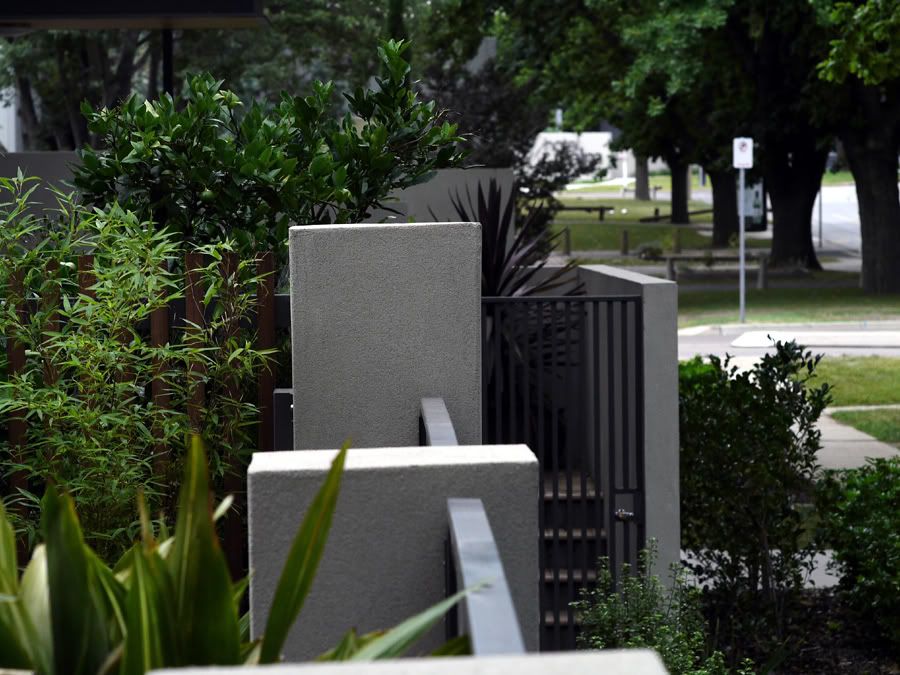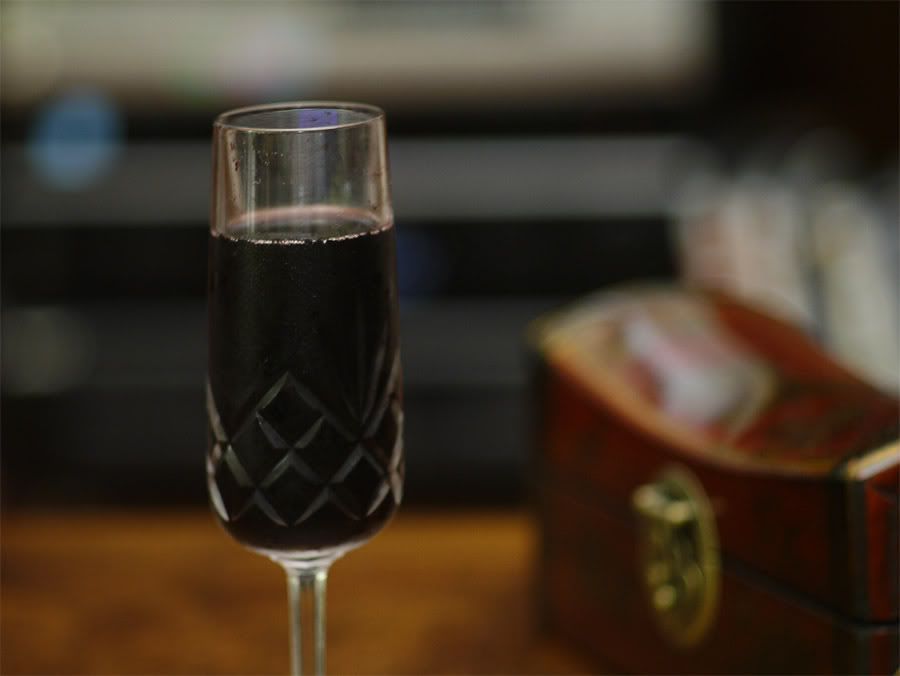| View previous topic :: View next topic |
| Author |
Message |
peterm1

Joined: 06 Dec 2007
Posts: 224
|
 Posted: Sat Jan 05, 2008 9:24 pm Post subject: Pentax SMC 85mm f1.8 Posted: Sat Jan 05, 2008 9:24 pm Post subject: Pentax SMC 85mm f1.8 |
 |
|
peterm1 wrote:
I am progressively working through my manual lenses now that I have a digital camera that can accommodate them. I took this picture this morning in my front courtyard. I am very happy with it. The focus point is the furthest pillar and you can all of the texture in it. I gave it only the smallest amount of sharpening (which I do with all digital shots.) The color is really nice too. I really must use this fella more often.
The one problem is focusing when shooting wide open. My old eyes are not up to it. But if you nail it the image really pops. It has nice bokeh too wide open. I will try to find some shots taken with it set this way.

_________________
PeterM |
|
| Back to top |
|
 |
Attila


Joined: 24 Feb 2007
Posts: 57865
Location: Hungary
Expire: 2025-11-18
|
 Posted: Sat Jan 05, 2008 9:27 pm Post subject: Posted: Sat Jan 05, 2008 9:27 pm Post subject: |
 |
|
Attila wrote:
I have this lens with broken !? front lens at edge , takes great captures as well like new 
_________________
-------------------------------
Items on sale on Ebay
Sony NEX-7 Carl Zeiss Planar 85mm f1.4, Minolta MD 35mm f1.8, Konica 135mm f2.5, Minolta MD 50mm f1.2, Minolta MD 250mm f5.6, Carl Zeiss Sonnar 180mm f2.8
|
|
| Back to top |
|
 |
LucisPictor


Joined: 26 Feb 2007
Posts: 17633
Location: Oberhessen, Germany / Maidstone ('95-'96)
Expire: 2013-12-03
|
 Posted: Sat Jan 05, 2008 10:43 pm Post subject: Posted: Sat Jan 05, 2008 10:43 pm Post subject: |
 |
|
LucisPictor wrote:
Very nice! I love these parameters: 85mm f1.8!
_________________
Personal forum activity on pause every now and again (due to job obligations)!
Carsten, former Moderator 
Things ON SALE
Carsten = "KAPCTEH" = "Karusutenu" | T-shirt?.........................My photos from Emilia: http://www.schouler.net/emilia/emilia2011.html
My gear: http://retrocameracs.wordpress.com/ausrustung/
Old list: http://forum.mflenses.com/viewtopic.php?t=65 (Not up-to-date, sorry!) | http://www.lucispictor.de | http://www.alensaweek.wordpress.com |
http://www.retrocamera.de |
|
| Back to top |
|
 |
peterm1

Joined: 06 Dec 2007
Posts: 224
|
 Posted: Sat Jan 05, 2008 11:18 pm Post subject: Posted: Sat Jan 05, 2008 11:18 pm Post subject: |
 |
|
peterm1 wrote:
I wonder what it is about 85s, 105s and 135s? These focal lengths all tended to have particularly good lenses from the big name designers and manufacturers.
Is it that these were the "signature" focal lengths so they went all out to design good lenses for them, knowing that these would make or break their name in the market place. Or is it because there is something about these short to medium telephotos optically that made them easier to design? Perhaps a bit of both.
Even if they had features that allowed an "easier" design, the designer had choices to make. I have read that the earlier (pre-AI) Nikkor 105s were designed as true telephotos ie they were optimized for medium to long distances based upon the earlier still rangefinder design and lens usages. Later when these were redesigned they realized that many of these were now more likely to be used for portraits so optimized them for shorter ranges.
_________________
PeterM |
|
| Back to top |
|
 |
Abbazz


Joined: 23 Jun 2007
Posts: 1098
Location: Jakarta
|
 Posted: Sun Jan 06, 2008 12:02 am Post subject: Posted: Sun Jan 06, 2008 12:02 am Post subject: |
 |
|
Abbazz wrote:
| peterm1 wrote: |
| Or is it because there is something about these short to medium telephotos optically that made them easier to design? |
You nailed it.
Lenses shorter than 55/58mm need an additional diverging element in order to clear the mirror of an SLR camera (their optical draw is longer than their focal lens). Unfortunately this additional element also adds many aberrations and a lot of distortion. These can be corrected to some extent by adding more glass elements or by using aspherical surfaces. Anyway, the shorter the focal length, the more difficult it is to build a good lens.
Lenses longer than 135mm tend to suffer from chromatic aberrations, which increase with lens magnification. The most common way to deal with the problem is to use low dispersion glass, like glass containing fluorite (e.g. ED glass) but then again, the correction is never perfect and the use of special glasses is limited by the price factor.
Cheers!
Abbazz
_________________
Il n'y a rien dans le monde qui n'ait son moment decisif, et le chef-d'oeuvre de la bonne conduite est de connaitre et de prendre ce moment. - Cardinal de Retz
The 6x9 Photography Online Resource:
http://artbig.com/ |
|
| Back to top |
|
 |
Orio

Joined: 24 Feb 2007
Posts: 29545
Location: West Emilia
Expire: 2012-12-04
|
 Posted: Sun Jan 06, 2008 12:08 am Post subject: Posted: Sun Jan 06, 2008 12:08 am Post subject: |
 |
|
Orio wrote:
| Abbazz wrote: |
You nailed it.
Lenses shorter than 55/58mm need an additional diverging element in order to clear the mirror of an SLR camera (their optical draw is longer than their focal lens). Unfortunately this additional element also adds many aberrations and a lot of distortion. These can be corrected to some extent by adding more glass elements or by using aspherical surfaces. Anyway, the shorter the focal length, the more difficult it is to build a good lens. |
Exactly, the retrofocus scheme is basically an inverted tele lens that is placed in the bottom of the optical scheme to allow for the reduction of the focal lenght.
| Abbazz wrote: |
| Lenses longer than 135mm tend to suffer from chromatic aberrations, which increase with lens magnification. The most common way to deal with the problem is to use low dispersion glass, like glass containing fluorite (e.g. ED glass) but then again, the correction is never perfect and the use of special glasses is limited by the price factor. |
Yes, and special glasses and true-glass aspherical lenses is why those Apo-Tessars and Apo-Elmarits cost a fortune. 
-
_________________
Orio, Administrator
T*
NE CEDE MALIS AUDENTIOR ITO
Ferrania film is reborn! http://www.filmferrania.it/
Support the Ornano film chemicals company and help them survive!
http://forum.mflenses.com/ornano-chemical-products-t55525.html |
|
| Back to top |
|
 |
peterm1

Joined: 06 Dec 2007
Posts: 224
|
 Posted: Sun Jan 06, 2008 12:10 am Post subject: Posted: Sun Jan 06, 2008 12:10 am Post subject: |
 |
|
peterm1 wrote:
Thanks Abbazz. I should have thought about that. When stated that way its obvious. (As most good ideas are.) Cheers.
Certainly I was going to add that I had noticed that longer focal lengths like this often have fewer elements and of course, your explanation is the reason. It is part of the reason too why I respect what I call lenses with "modest" design specs. It seems to be exponentially harder to design a lens with just that extra half a stop or a stop of coverage while retaining image quality. Part of the reason no doubt that Leica glass is so damn expensive, together with the build quality is that these are amongst the lenses that you can shoot wide open without serious degradation.
But it remains that so often the slower lens (ie with a simpler lens element layout) is the substantially better lens when it comes to image making - Not always; there are some excellent faster lenses - the 50mm Nikkor 1.4 and the 50mm Takumar 1.4 being cases in point where they approach the resolution of the 1.8 versions. (Which themselves are regarded as being exceptional.)
_________________
PeterM |
|
| Back to top |
|
 |
LucisPictor


Joined: 26 Feb 2007
Posts: 17633
Location: Oberhessen, Germany / Maidstone ('95-'96)
Expire: 2013-12-03
|
 Posted: Sun Jan 06, 2008 9:46 am Post subject: Posted: Sun Jan 06, 2008 9:46 am Post subject: |
 |
|
LucisPictor wrote:
That's the main reason why wide angle lenses for rangefinder cams can be so amazingly good: no mirror. 
_________________
Personal forum activity on pause every now and again (due to job obligations)!
Carsten, former Moderator 
Things ON SALE
Carsten = "KAPCTEH" = "Karusutenu" | T-shirt?.........................My photos from Emilia: http://www.schouler.net/emilia/emilia2011.html
My gear: http://retrocameracs.wordpress.com/ausrustung/
Old list: http://forum.mflenses.com/viewtopic.php?t=65 (Not up-to-date, sorry!) | http://www.lucispictor.de | http://www.alensaweek.wordpress.com |
http://www.retrocamera.de |
|
| Back to top |
|
 |
peterm1

Joined: 06 Dec 2007
Posts: 224
|
 Posted: Sun Jan 06, 2008 12:41 pm Post subject: Posted: Sun Jan 06, 2008 12:41 pm Post subject: |
 |
|
peterm1 wrote:
I said I would try to find some wide open shots. Here is one. I did not quite nail the focus correctly (on the glass) but this shot demonstrates the lovely soft bokeh of this lens when shot wide open (the box behind the glass.)
On reflection, the DOF of this lens at this distance, wide open is so small that it may be impossible to get the whole glass in focus. Note that the front lip of the top of the glass is reasonable but the stem is well out of focus.

_________________
PeterM |
|
| Back to top |
|
 |
Abbazz


Joined: 23 Jun 2007
Posts: 1098
Location: Jakarta
|
 Posted: Sun Jan 06, 2008 1:19 pm Post subject: Posted: Sun Jan 06, 2008 1:19 pm Post subject: |
 |
|
Abbazz wrote:
| peterm1 wrote: |
| I did not quite nail the focus correctly (on the glass) but this shot demonstrates the lovely soft bokeh of this lens when shot wide open (the box behind the glass.) |
Great shot, Peter.
The bokeh of this lens is indeed lovely. As it is also less prone to purple fringing than the 77/1.8 Limited, I use my SMC-Takumar 85/1.8 a lot more.
Cheers!
Abbazz
_________________
Il n'y a rien dans le monde qui n'ait son moment decisif, et le chef-d'oeuvre de la bonne conduite est de connaitre et de prendre ce moment. - Cardinal de Retz
The 6x9 Photography Online Resource:
http://artbig.com/ |
|
| Back to top |
|
 |
|
|
|
You cannot post new topics in this forum
You cannot reply to topics in this forum
You cannot edit your posts in this forum
You cannot delete your posts in this forum
You cannot vote in polls in this forum
|
